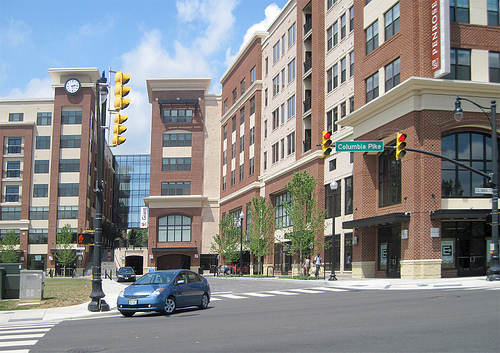Streetcar won’t make Columbia Pike unaffordable

Photo by cliff1066â„¢ on Flickr.
Some residents have expressed concern that the Columbia Pike Streetcar will bring changes to the Columbia Pike area. Besides traffic impacts, another oft-repeated criticism is that streetcar-oriented development will harm the relative affordability of many areas along Columbia Pike.
The price of housing has soared in the areas of Arlington that are close to the Metro. It is likely that the streetcar will create a similar effect. Meanwhile, Arlington has the second-lowest amount of affordable housing in the Commonwealth of Virginia.
In response, the county has devised one of the more aggressive responses to providing affordable housing in the region. The Arlington County Board passed the Columbia Pike Neighborhood Plan last July to address many questions surrounding the future of Columbia Pike, including housing affordability.
The neighborhood plan covers much more than affordable housing. It deals with zoning, transportation, open space, schools, parking, preservation, and more. The plan is comprehensive and ambitious because it is a plan by the county to preserve 100% of the “Committed Affordable Units” (CAFs) currently in the planning area of the Neighborhood Plan. This is much higher than the county-wide requirement to retain 50% of CAFs in any redevelopment project.
We’re talking about two types of affordable housing
There are two types of affordable housing in the plan. CAFs are housing owned by a non-profit organization or subsidized at some level of government.
“Market Rate Affordable Units” (MARKs) are housing units that are not subsidized in any way, but whose market price is low enough to be affordable to families or individuals making below the Area Median Income (AMI). For MARKs, there is no obligation for the landlord to keep the price below the market rate.
Critics of the Columbia Pike Streetcar usually contend that the streetcar is meant as a tool to gentrify the corridor and eliminate affordable housing on Columbia Pike. This ignores the county’s commitment to preserve and expand CAF’s throughout the corridor. Moreover, when critics speak of the loss of affordable housing, they mean the loss of MARK’s that the private sector isn’t obligated to provide.
Actually, absent the fixes prescribed in the Neighborhood Plan, all of the MARKs located in the corridor will disappear regardless of whether the streetcar is built or not. That’s because, due to Arlington’s location just outside of Washington, DC, Arlington is a very popular place to live.
The staff report on the Neighborhoods Plan has a table that lays out what county officials expect to happen. By 2040, Columbia Pike will not be able to retain MARK’s affordable at a level of 60% AMI. Apartments at 80% AMI will likely increase with the number of overall units.
To counter this, the county aims to triple the number of CAFs at 60% AMI from the current (as of 2010) 1,120 units to 4,730 by 2040. This is a huge part of the projected 14,000 new units by 2040.
So while the number of apartments today compared to 2040 is expected to grow three times its current size, the number of affordable apartments will also grow to twice its current number. Arlington County believes it will be able to achieve that growth through both financing incentives to developers to keep and add CAF’s and through the adoption of a Form-Based Code that will allow for greater and mixed-use density along Columbia Pike and its commercial areas.
Moreover, proposed buildings can get density bonuses if they provide more housing that meets the target of 80% AMI. Projects that share land with historic properties can also get density bonuses to preserve the older buildings.
Currently, the area defined in the Columbia Pike Neighborhood Plan only has 19% percent of the county’s total number of CAF’s. Meanwhile the county is planning on increasing the number of CAF’s in the area more than other areas of the county. This includes providing housing that is priced at 40% of AMI where no units in the planning area currently exist. The county is also redeveloping its own facilities as the Arlington Mill Recreation Center which will provide 122 new housing units for families making below 60% AMI.
Affordable housing concerns go beyond the streetcar or other development issues
Arlington County is a geographically small county located in the middle of a fast-growing area. Many other jurisdictions effectively provide affordable housing by allowing development farther from the core, but that is not an option for Arlington. This has forced the county to look at new ways of providing affordability. It wants to do so to preserve the county’s diversity.
Critics of the streetcar plan contend that the streetcar will eliminate MARKs along Columbia Pike, but that fails to recognize that much of that housing would be lost regardless, even with no streetcar, because of the overall market pressures on the entire region and the desire to live both closer to work and in more urban settings.
Trying to prevent any and all development would not help the area’s affordability either. Instead, it would eventually work against affordability by restricting the number of places for people to live. This is why it is important to lay out strategies to preserve the existing affordable housing and provide opportunities to plan for more. The Neighborhood Plan is a good start toward this goal.



